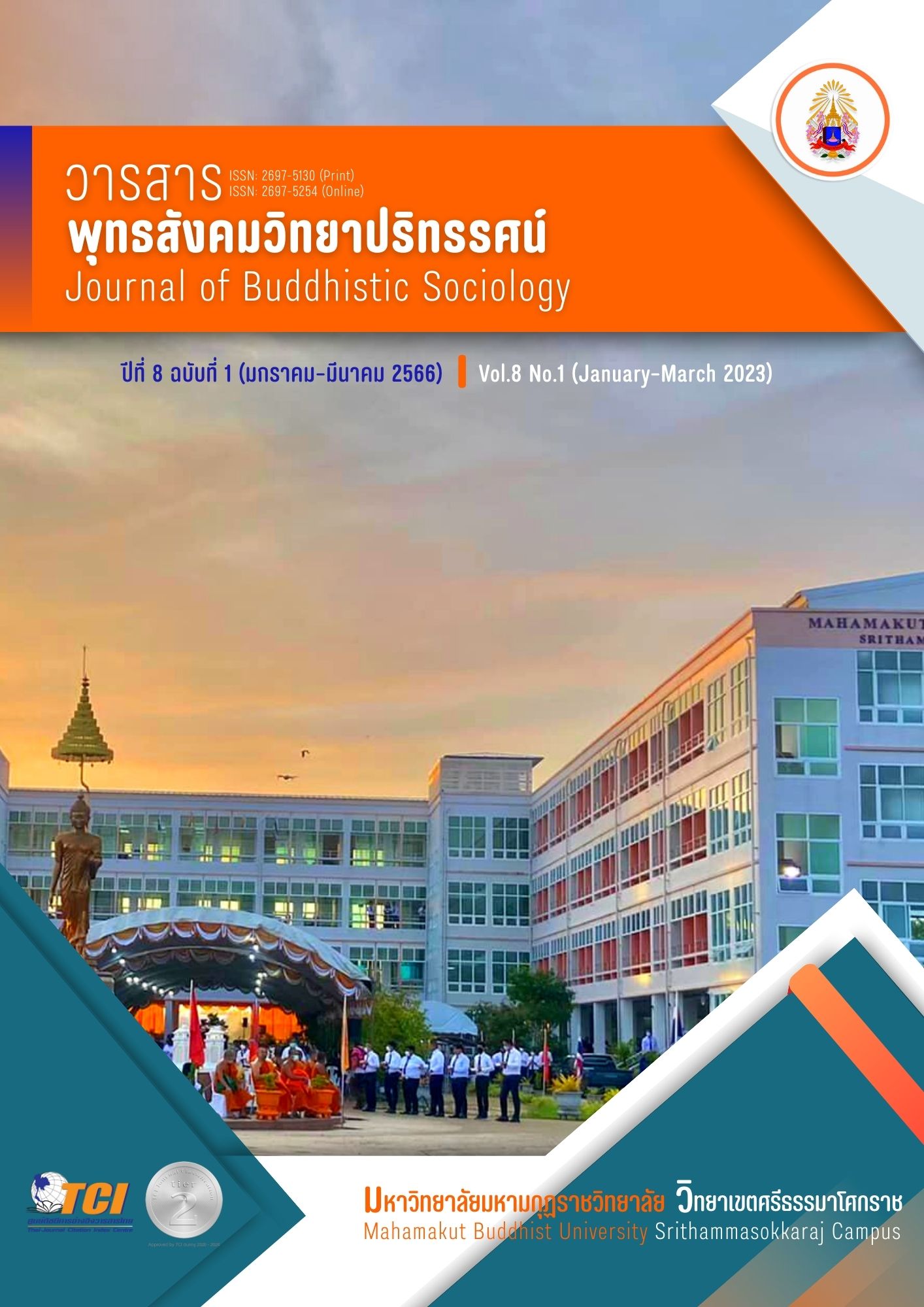การประเมินโครงการพัฒนาคุณธรรม จริยธรรมนักเรียน ของโรงเรียนบ้านโรงเหล็ก สำนักงานเขตพื้นที่การศึกษาประถมศึกษานครศรีธรรมราช เขต 4
Main Article Content
บทคัดย่อ
การประเมินโครงการในครั้งนี้มีวัตถุประสงค์เพื่อ 1) ประเมินบริบท 2) ประเมินปัจจัยนําเข้า 3) ประเมินกระบวนการดําเนินงาน และ 4) ประเมินผลผลิตของโครงการพัฒนาคุณธรรม จริยธรรมนักเรียนของโรงเรียนบ้านโรงเหล็ก สำนักงานเขตพื้นที่การศึกษาประถมศึกษานครศรีธรรมราช เขต 4 กลุ่มตัวอย่างที่ใช้ในการประเมินครั้งนี้ ผู้ประเมินกำหนดกลุ่มตัวอย่างโดยใช้ตารางสําเร็จรูปของ Krejcie & Morgan โดยทำการสุ่มแบบแบ่งชั้นภูมิ ได้แก่ ครู ผู้บริหารโรงเรียน นักเรียน ผู้ปกครองโรงเรียนบ้านโรงเหล็ก สำนักงานเขตพื้นที่การศึกษาประถมศึกษานครศรีธรรมราช เขต 4 จำนวนทั้งสิ้น 302 คน เครื่องมือที่ใช้ในการประเมิน คือ เป็นแบบมาตราส่วนประมาณค่า 5 ระดับ จำนวน 4 ฉบับ สถิติที่ใช้ในการวิเคราะห์ข้อมูล ได้แก่ ค่าร้อยละ ค่าเฉลี่ย และส่วนเบี่ยงเบนมาตรฐาน
ผลการวิจัยพบว่า
1. การประเมินผลด้านบริบท โครงการพัฒนาคุณธรรม จริยธรรมนักเรียนของโรงเรียนบ้านโรงเหล็ก สำนักงานเขตพื้นที่การศึกษาประถมศึกษานครศรีธรรมราช เขต 4 ในภาพรวม มีความเหมาะสมอยู่ในระดับมากที่สุด
2. การประเมินด้านปัจจัยนําเข้า โครงการพัฒนาคุณธรรม จริยธรรมนักเรียนของโรงเรียนบ้านโรงเหล็ก สำนักงานเขตพื้นที่การศึกษาประถมศึกษานครศรีธรรมราช เขต 4 ในภาพรวมมีความเหมาะสมอยู่ในระดับมาก
3. การประเมินด้านกระบวนการดําเนินงาน โครงการพัฒนาคุณธรรม จริยธรรมนักเรียนของโรงเรียนบ้านโรงเหล็ก สำนักงานเขตพื้นที่การศึกษาประถมศึกษานครศรีธรรมราช เขต 4 ในภาพรวมอยู่ในระดับมาก
4.การประเมินด้านประเมินผลผลิต โครงการพัฒนาคุณธรรม จริยธรรมนักเรียนของโรงเรียนบ้านโรงเหล็ก สำนักงานเขตพื้นที่การศึกษาประถมศึกษานครศรีธรรมราช เขต 4 ในภาพรวมอยู่ในระดับมากที่สุด
Article Details

อนุญาตภายใต้เงื่อนไข Creative Commons Attribution-NonCommercial-NoDerivatives 4.0 International License.
เอกสารอ้างอิง
กระทรวงศึกษาธิการ. (2550). พระราชบัญญัติการศึกษาแห่งชาติ พ.ศ. 2542 และแก้ไขเพิ่มเติม (ฉบับที่2) พ.ศ.2545 (ฉบับที่3) พ.ศ. 2553. กรุงเทพมหานคร: กระทรวงศึกษาธิการ.
จิมารัตน์ ปุญญปัญญา. (2557). การประเมินโครงการพัฒนาคุณธรรมจริยธรรมเพื่อเสริมสร้างคุณลักษณะ “ยอดนารีสตรีวิทยา. เรียกใช้เมื่อ 30 กรกฎาคม 2564 จาก http://www.kroobannok.com/board_view.php?b_id=7784&bcat_id=16.
ชฎาพร เสนเผือก. (2560). รายงานการประเมินโครงการพัฒนาคุณธรรมนักเรียนตามแนวการดําเนินงานโรงเรียนคุณธรรม โรงเรียนวัดปากจ่า. สงขลา: โรงเรียนวัดปากจ่า.
ฐกฤต อัชณาพิพัฒ. (2560). การประเมินโครงการส่งเสริมคุณธรรมจริยธรรมโรงเรียนบ้านนาวง สํานักงานเขตพื้นที่การศึกษาประถมศึกษาพัทลุง เขต 1. พัทลุง: โรงเรียนบ้านนาวง.
ธีรัตม์ ใจกล้า. (2560). รายงานการประเมินโครงการโรงเรียนส่งเสริมคุณธรรมจริยธรรม โรงเรียนบ้านตระเปียงเดีย สังกัดสำนักงานเขตพื้นที่การศึกษาประถมศึกษาสุรินทร์ เขต 1. สุรินทร์: โรงเรียนบ้านตระเปียงเดีย.
บุญชม ศรีสะอาด. (2560). การวิจัยเบื้องต้น (พิมพ์ครั้งที่ 10). กรุงเทพมหานคร: สุวีริยสาสน์.
พิชัย อันปัญญา. (2554). การประเมินโครงการพัฒนาคุณธรรม จริยธรรมและค่านิยมที่พึงประสงค์ของนักเรียนโรงเรียนเทศบาลบ้านล่องนางใย. มหาสารคาม: โรงเรียนเทศบาลบ้านส่องนางใย.
สํานักงานเลขาธิการสภาการศึกษา. (2560). แผนการศึกษาแห่งชาติ พ.ศ. 2560 – 2579. กรุงเทพมหานคร: สํานักงานเลขาธิการสภาการศึกษา.
สำนักงานเลขาธิการวุฒิสภา. (2560). รัฐธรรมนูญแห่งราชอาณาจักรไทย พุทธศักราช 2560 (พิมพ์ครั้งที่ 3). กรุงเทพมหานคร: สำนักงานเลขาธิการวุฒิสภา.
อาทิตย์ สาทา. (2558). การประเมินโครงการพัฒนาคุณธรรมจริยธรรมของนักเรียน โรงเรียนเทศบาล 1 (อนุบาลเด็กน่ารัก) สังกัดเทศบาลตําบลหนองบัวแดง อําเภอหนองบัวแดง จังหวัดชัยภูมิ. ชัยภูมิ: โรงเรียนเทศบาล 1.
Krejcie, R. V. & Morgan, D. W. . (1970). Determining Sample Size for Research Scillities. Education and Phychological Measurement, 30(3), 607-610.


